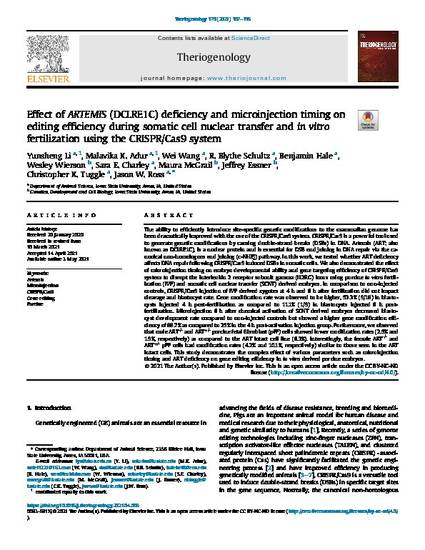
The ability to efficiently introduce site-specific genetic modifications to the mammalian genome has been dramatically improved with the use of the CRISPR/Cas9 system. CRISPR/Cas9 is a powerful tool used to generate genetic modifications by causing double-strand breaks (DSBs) in DNA. Artemis (ART; also known as DCLRE1C), is a nuclear protein and is essential for DSB end joining in DNA repair via the canonical non-homologous end joining (c-NHEJ) pathway. In this work, we tested whether ART deficiency affects DNA repair following CRISPR/Cas9 induced DSBs in somatic cells. We also demonstrated the effect of microinjection timing on embryo developmental ability and gene targeting efficiency of CRISPR/Cas9 system to disrupt the interleukin 2 receptor subunit gamma (IL2RG) locus using porcine in vitro fertilization (IVF) and somatic cell nuclear transfer (SCNT) derived embryos. In comparison to non-injected controls, CRISPR/Cas9 injection of IVF derived zygotes at 4 h and 8 h after fertilization did not impact cleavage and blastocyst rate. Gene modification rate was observed to be higher, 53.3% (9/16) in blastocysts injected 4 h post-fertilization as compared to 11.1% (1/9) in blastocysts injected 8 h post-fertilization. Microinjection 8 h after chemical activation of SCNT derived embryos decreased blastocyst development rate compared to non-injected controls but showed a higher gene modification efficiency of 66.7% as compared to 25% in the 4 h post-activation injection group. Furthermore, we observed that male ART-/- and ART+/- porcine fetal fibroblast (pFF) cells showed lower modification rates (2.5% and 1.9%, respectively) as compared to the ART intact cell line (8.3%). Interestingly, the female ART-/- and ART+/- pFF cells had modification rates (4.2% and 10.1%, respectively) similar to those seen in the ART intact cells. This study demonstrates the complex effect of various parameters such as microinjection timing and ART deficiency on gene editing efficiency in in vitro derived porcine embryos.
Available at: http://works.bepress.com/maura-mcgrail/22/

This article is published as Li, Yunsheng, Malavika K. Adur, Wei Wang, R. Blythe Schultz, Benjamin Hale, Wesley Wierson, Sara E. Charley et al. "Effect of ARTEMIS (DCLRE1C) deficiency and microinjection timing on editing efficiency during somatic cell nuclear transfer and in vitro fertilization using the CRISPR/Cas9 system." Theriogenology 170 (2021): 107-116. doi:10.1016/j.theriogenology.2021.04.003.